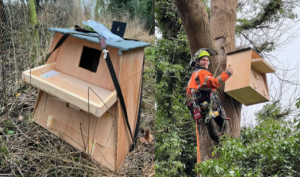Bats bed down for winter in the woodland
Monday 27th November 2023
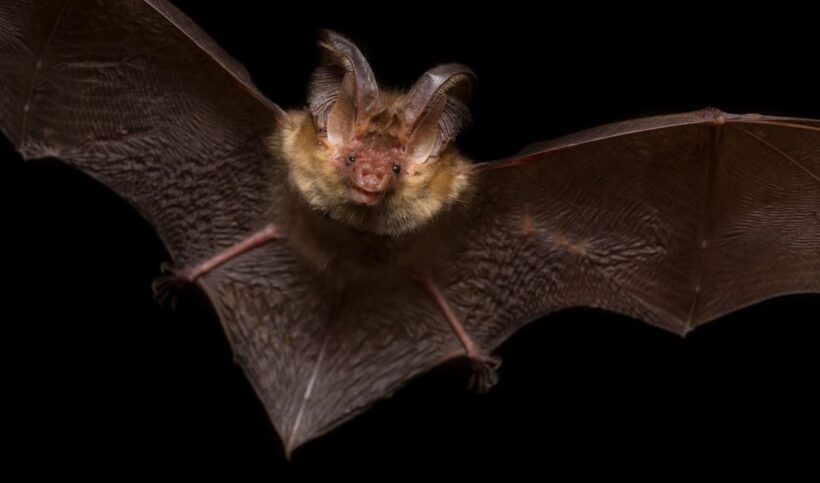
In our household, we’re at that time of year when there is a constant battle over the thermostat. I’m very much of the mindset that when the temperature drops, it’s just a cue to put on another jumper, but I eventually concede to alternative forms of warmth, even if it’s just to dry the washing!
Winter strategies to cope with the cold
All of us mammals need to come up with strategies to keep warm when the ‘mercury’ drops. Some adopt a very different approach to us and get their heads down for the whole winter. While several species reduce their activity when it gets really cold, only three groups truly hibernate in the UK: the dormouse, the hedgehog and, of course, our native species of bats.
At about this time of year, bats’ food source – largely insects – gets thin on the ground. So, like other animals that hibernate, they have ‘decided’ it’s better to cut their losses when the temperature drops and not waste energy finding food and trying to stay warm. They choose to find somewhere safe, allow their body temperature to drop and their breathing and heart rate to fall, and as a result, their energy demand becomes minimal.
Fascinating facts about bats
As they are nocturnal, it is easy for us to overlook these fascinating creatures when we run our educational sessions in the woodland. Big badgers leave obvious signs of their, sometimes clumsy, night-time activities and we often catch sight of a wily fox out scavenging during daylight, but the bats are usually well tucked-up by the time we are out and about.
Did you know there are 17 species of bats breeding in the UK, and contrary to popular opinion, they don’t all hang out in caves? The majority of species choose to roost in trees – the older, the better – and where trees aren’t available, they’ll happily make their way into nooks and crannies in buildings. They’ll squeeze themselves into crevices and huddle together in an effort to stay as warm as possible.
Due to the fact that they’re usually only seen at night, you may not realise how small bats are. One of the most common species, and one I have often recorded here in Science Oxford’s woodland, is the Common Pipistrelle (Pipistrellus pipistrellus) which measures just 5cm from head to tail and weighs in at less than 8g, or the mass of a pound coin! Its membranous wings make it look much bigger in flight but it is even smaller than the tiny dormouse.
Another of my favourites, the Brown Long-eared Bat (Plecotus auritus) is capable of slow, almost hovering, flight while using their large ears (as the name suggests!) to search for prey. Capable of consuming thousands of insects per night, most bats will hold up during the day and are happy roosting in crevices of trees while the sun is up.
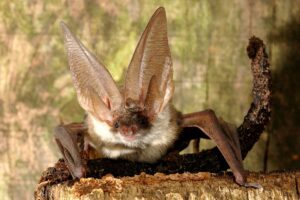
During the summer, I witnessed the unusual day-time appearance of a Daubenton’s bat (Myotis daubentonii), a species occasionally seen during the day and strongly associated with waterways, flying and feeding over our ponds. Most likely due to it having hungry mouths to feed and taking advantage of a warm quiet day, this particular individual was willing to take its chances being active during daylight, despite the higher risk of predation.
How to help a bat
If you ever see a distressed bat during the day, then you should call the National Bat Helpline (0345 1300 228) which provides advice. Bearing in mind bats are protected by law, you are allowed to handle a bat in order to help it. Due to the small risk of bats in the UK carrying rabies, it is always advised that you wear gloves in such situations.
Bats are under threat
Among the biggest threats to bats across the world are disease, pollution and loss of habitats. Bats are highly susceptible to a range of pollution, particularly the use of pesticides and the effect it has on their insect prey. Light pollution, caused by the increase in use of artificial lighting, has a significant impact on the behaviour of bats and can even cause them to change habits or become entombed to the point where they won’t leave their roosts.
Possibly the biggest impact is caused by loss of habitats as old trees are felled and buildings are demolished, with no consideration given to these lesser-spotted creatures.
Providing suitable roosts
To improve the suitability of our grounds for bats, we have installed a number of different designs of bat boxes on our buildings and across our woodlands at the Science Oxford Centre, and attempt to maintain suitable roosts among the trees.
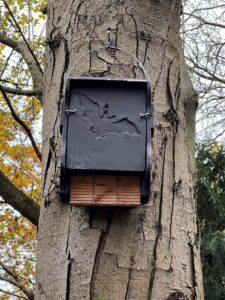
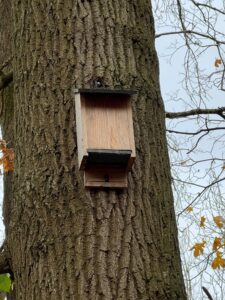
Find out more about bats
One of the best ways to find out more about bats is to head on over to the Bat Conservation Trust’s website, where you can sign up to volunteer with them or attend a bat event. If you are really interested, I’d strongly recommend getting yourself a simple bat detector that allows you to monitor what bats live in your area and identify them through the frequency of their calls. Even within the urban environment of our towns and villages, you’ll be able to pick up the echolocation calls of several species of bat once they emerge from hibernation next spring and then you too can help improve the environment they live in!



